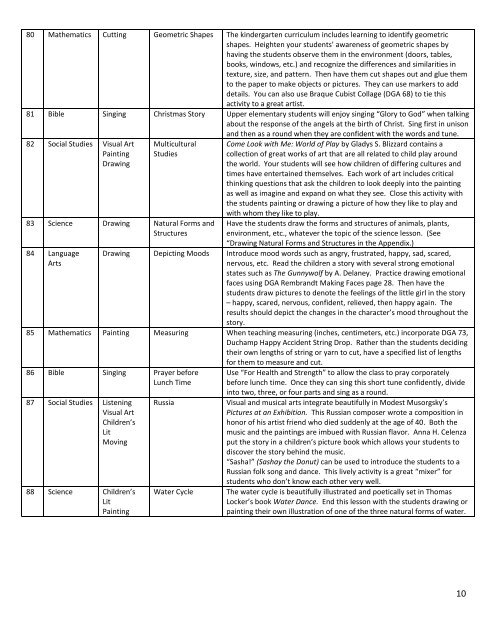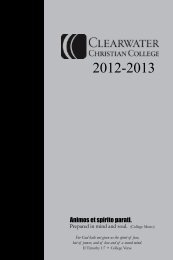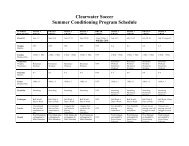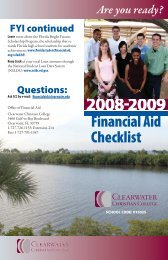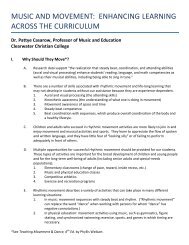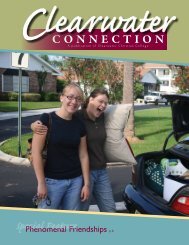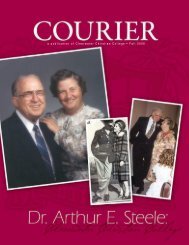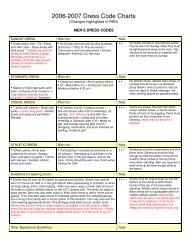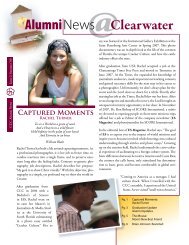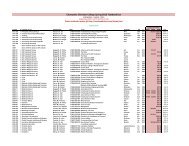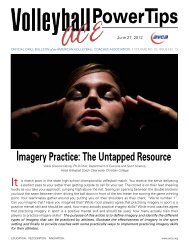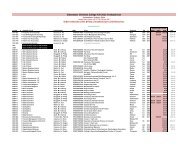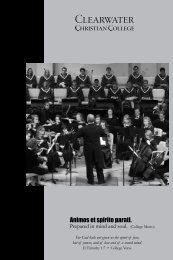101 Ways to Enrich Your Teaching with the Arts - Clearwater ...
101 Ways to Enrich Your Teaching with the Arts - Clearwater ...
101 Ways to Enrich Your Teaching with the Arts - Clearwater ...
- No tags were found...
You also want an ePaper? Increase the reach of your titles
YUMPU automatically turns print PDFs into web optimized ePapers that Google loves.
80 Ma<strong>the</strong>matics Cutting Geometric Shapes The kindergarten curriculum includes learning <strong>to</strong> identify geometric<br />
shapes. Heighten your students’ awareness of geometric shapes by<br />
having <strong>the</strong> students observe <strong>the</strong>m in <strong>the</strong> environment (doors, tables,<br />
books, windows, etc.) and recognize <strong>the</strong> differences and similarities in<br />
texture, size, and pattern. Then have <strong>the</strong>m cut shapes out and glue <strong>the</strong>m<br />
<strong>to</strong> <strong>the</strong> paper <strong>to</strong> make objects or pictures. They can use markers <strong>to</strong> add<br />
details. You can also use Braque Cubist Collage (DGA 68) <strong>to</strong> tie this<br />
activity <strong>to</strong> a great artist.<br />
81 Bible Singing Christmas S<strong>to</strong>ry Upper elementary students will enjoy singing “Glory <strong>to</strong> God” when talking<br />
about <strong>the</strong> response of <strong>the</strong> angels at <strong>the</strong> birth of Christ. Sing first in unison<br />
and <strong>the</strong>n as a round when <strong>the</strong>y are confident <strong>with</strong> <strong>the</strong> words and tune.<br />
82 Social Studies Visual Art<br />
Painting<br />
Drawing<br />
Multicultural<br />
Studies<br />
83 Science Drawing Natural Forms and<br />
Structures<br />
84 Language<br />
<strong>Arts</strong><br />
Come Look <strong>with</strong> Me: World of Play by Gladys S. Blizzard contains a<br />
collection of great works of art that are all related <strong>to</strong> child play around<br />
<strong>the</strong> world. <strong>Your</strong> students will see how children of differing cultures and<br />
times have entertained <strong>the</strong>mselves. Each work of art includes critical<br />
thinking questions that ask <strong>the</strong> children <strong>to</strong> look deeply in<strong>to</strong> <strong>the</strong> painting<br />
as well as imagine and expand on what <strong>the</strong>y see. Close this activity <strong>with</strong><br />
<strong>the</strong> students painting or drawing a picture of how <strong>the</strong>y like <strong>to</strong> play and<br />
<strong>with</strong> whom <strong>the</strong>y like <strong>to</strong> play.<br />
Have <strong>the</strong> students draw <strong>the</strong> forms and structures of animals, plants,<br />
environment, etc., whatever <strong>the</strong> <strong>to</strong>pic of <strong>the</strong> science lesson. (See<br />
“Drawing Natural Forms and Structures in <strong>the</strong> Appendix.)<br />
Drawing Depicting Moods Introduce mood words such as angry, frustrated, happy, sad, scared,<br />
nervous, etc. Read <strong>the</strong> children a s<strong>to</strong>ry <strong>with</strong> several strong emotional<br />
states such as The Gunnywolf by A. Delaney. Practice drawing emotional<br />
faces using DGA Rembrandt Making Faces page 28. Then have <strong>the</strong><br />
students draw pictures <strong>to</strong> denote <strong>the</strong> feelings of <strong>the</strong> little girl in <strong>the</strong> s<strong>to</strong>ry<br />
– happy, scared, nervous, confident, relieved, <strong>the</strong>n happy again. The<br />
results should depict <strong>the</strong> changes in <strong>the</strong> character’s mood throughout <strong>the</strong><br />
s<strong>to</strong>ry.<br />
85 Ma<strong>the</strong>matics Painting Measuring When teaching measuring (inches, centimeters, etc.) incorporate DGA 73,<br />
Duchamp Happy Accident String Drop. Ra<strong>the</strong>r than <strong>the</strong> students deciding<br />
<strong>the</strong>ir own lengths of string or yarn <strong>to</strong> cut, have a specified list of lengths<br />
for <strong>the</strong>m <strong>to</strong> measure and cut.<br />
86 Bible Singing Prayer before<br />
Lunch Time<br />
87 Social Studies Listening<br />
Visual Art<br />
Children’s<br />
Lit<br />
Moving<br />
88 Science Children’s<br />
Lit<br />
Painting<br />
Russia<br />
Water Cycle<br />
Use “For Health and Strength” <strong>to</strong> allow <strong>the</strong> class <strong>to</strong> pray corporately<br />
before lunch time. Once <strong>the</strong>y can sing this short tune confidently, divide<br />
in<strong>to</strong> two, three, or four parts and sing as a round.<br />
Visual and musical arts integrate beautifully in Modest Musorgsky’s<br />
Pictures at an Exhibition. This Russian composer wrote a composition in<br />
honor of his artist friend who died suddenly at <strong>the</strong> age of 40. Both <strong>the</strong><br />
music and <strong>the</strong> paintings are imbued <strong>with</strong> Russian flavor. Anna H. Celenza<br />
put <strong>the</strong> s<strong>to</strong>ry in a children’s picture book which allows your students <strong>to</strong><br />
discover <strong>the</strong> s<strong>to</strong>ry behind <strong>the</strong> music.<br />
“Sasha!” (Sashay <strong>the</strong> Donut) can be used <strong>to</strong> introduce <strong>the</strong> students <strong>to</strong> a<br />
Russian folk song and dance. This lively activity is a great “mixer” for<br />
students who don’t know each o<strong>the</strong>r very well.<br />
The water cycle is beautifully illustrated and poetically set in Thomas<br />
Locker’s book Water Dance. End this lesson <strong>with</strong> <strong>the</strong> students drawing or<br />
painting <strong>the</strong>ir own illustration of one of <strong>the</strong> three natural forms of water.<br />
10


